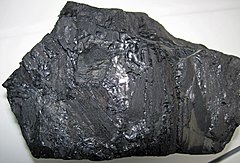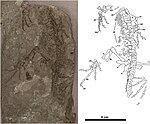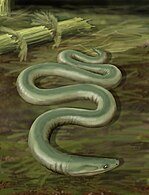Allegheny Group
| Allegheny Group | |
|---|---|
| Stratigraphic range: (Moscovian) ~306.8–311 Ma PreꞒ Ꞓ O S D C P T J K Pg N ↓ | |
 Bituminous coal (Clarion Coal) from the Allegheny Group, Ohio | |
| Type | Sedimentary |
| Sub-units | Freeport Formation
Kittanning Formation
|
| Underlies | Conemaugh Group |
| Overlies | Kanawha Formation and Pottsville Formation |
| Lithology | |
| Primary | Sandstone, coal |
| Location | |
| Region | Appalachian Mountains |
| Country | United States |
| Extent | Pennsylvania, Maryland, West Virginia, Ohio |
| Type section | |
| Named by | H. D. Rogers, 1840[1] |
The Allegheny Group, often termed the Allegheny Formation,[2] is a Pennsylvanian-age geological unit in the Appalachian Plateau. It is a major coal-bearing unit in the eastern United States, extending through western and central Pennsylvania, western Maryland and West Virginia, and southeastern Ohio. Fossils of fishes such as Bandringa are known from the Kittaning Formation,[3] which is part of the Allegheny Group.
Stratigraphy
In Pennsylvania, the Allegheny Group includes rocks from the base of the Brooksville Coal to the top of the Upper Freeport Coal, and was defined to include all economically significant coals in the upper Pennsylvanian sequence.[4] The unit consists of cyclothemic sequences of coal, shale, limestone, sandstone, and clay. It contains six major coal zones, which, in stratigraphic order, are:
- Upper Freeport Coal
- Lower Freeport Coal
- Upper Kittanning Coal
- Middle Kittanning Coal
- Lower Kittanning Coal
- Brookville Coal
Members
Glen Richey (PA), Laurel Run (PA), Mineral Springs (PA), Millstone Run (PA), Clearfield Creek (PA); Clarion (OH, MD, PA, WV), Kittanning (PA), Freeport (PA, MD, OH, WV); Putnam Hill (OH, PA); Vanport (PA, MD, OH, WV); Butler (MD, PA), Worthington (MD, PA); Washingtonville (OH, PA, WV), Columbiana (OH)[5]
Age
Relative age dating of the Allegheny places it about mid-way through the Pennsylvanian, the second subperiod of the Carboniferous period. The plant and conchostracan fossils in particular can be equated with European strata of the "Asturian" (Westphalian D) regional stage. In North America, the roughly equivalent regional stage is known as the Desmoinesian.[2] The Asturian has an estimated age of 310.7 to 307.5 million years ago (Ma), equivalent to the latter half of the global Moscovian stage.[6]
Notable sites
The Allegheny Group has the richest fauna of tetrapod fossils in the entire Appalachian Basin, and practically all of these fossils are concentrated at the Linton site of Ohio.[7][8]
Linton was once a tiny village at the mouth of Yellow Creek (Saline Township) in Jefferson County. The nearby Diamond Coal Mine was active from 1855 to 1892, and again from 1917 to 1921, when the drift mine was permanently closed. The drift mine collapsed soon afterwards and the settlement diminished into obscurity. The main Diamond coal seam is likely equivalent to the Upper Freeport coal. John S. Newberry, from Columbia University and Chief Geologist of the Geological Survey of Ohio, was the first paleontologist to investigate the Linton area.[9] Starting in 1856, he collected thousands of fossils from the mine. Under the stewardship of E.D. Cope, some of Newberry's fossils were transferred to the American Museum of Natural History (AMNH), and others to the Orton Geological Museum at The Ohio State University. Other 19th-century geologists who collected fossils from the site include Frank Howe Bradley (1865, on behalf of Yale), R. N. Fearon (1883, Harvard), and Thomas Stock (1888, British Museum and the National Museum of Natural History). Fossil collection extended into the 20th century, with expeditions led by Jesse Hyde (AMNH), A.S. Romer (Field Museum), Donald Baird (Harvard, Princeton), Richard Lund and David Hamilla (Carnegie). Over 7000 Linton fossils are now in the collections of at least 14 museums across three countries.[7][8]
A second fossiliferous site is Five Points, a similar coal deposit in Beaver Township of Mahoning County. The Five Points cannel coal mine was first publicized as a fossil site by Robert Hook and Donald Baird in 1994, who collected tetrapod fossils comparable to those found at Linton. However, the mine at Five Points was reclaimed around the same time, so the fossiliferous spoil piles are no longer accessible for further collection.[10][11]
Paleobiota
Tetrapod records from Hook & Baird (1986/1988)[7][8] unless stated otherwise:
Amniotes
| Amniotes of East Kirkton | |||
|---|---|---|---|
| Species | Locality | Notes | Images |
| Anthracodromeus longipes | Linton | A "protorothyridid" eureptile |  |
| Archaeothyris sp. | Linton | A possible ophiacodontid synapsid based on rare fragments |  |
| Carbonodraco lundi[12] | Linton | An acleistorhinid parareptile based on fossils previously referred to Cephalerpeton |  |
Temnospondyls
| Temnospondyls of East Kirkton | |||
|---|---|---|---|
| Species | Locality | Notes | Images |
| Adamanterpeton ohioensis[13] | Linton | A rare cochleosaurid edopoid, previously referred to "Gaudrya cf. latistoma" | |
| Erpetosaurus radiatus | Linton | A common eobrachyopid dvinosaur | |
| Isodectes obtusus[10] | Linton, Five Points[10] | An abundant eobrachyopid dvinosaur, previously known as Saurerpeton obtusum |  |
| Macrerpeton huxleyi | Linton | A rare temnospondyl, possibly an edopoid or dissorophoid[14] | |
| Palodromeus bairdi[11] | Five Points | The earliest-braching olsoniform dissorophoid, known from a single skull | |
| Platyrhinops lyelli | Linton | A common amphibamiform dissorophoid, previously considered a species of Amphibamus |  |
| Stegops newberryi | Linton | A rare spiny dissorophoid |  |
Lepospondyls
| Lepospondyls of East Kirkton | |||
|---|---|---|---|
| Species | Locality | Notes | Images |
| Brachydectes newberryi | Linton | A lysorophian, likely encompassing fossils previously referred to Pleuroptyx clavatus[15] (which are rare) and Cocytinus gyrinoides[16] (which are common) |  |
| Ctenerpeton remex | Linton | A rare urocordylid nectridean | |
| Diceratosaurus brevirostris | Linton | An abundant diplocaulid nectridean |  |
| Molgophis macrurus | Linton | A rare lysorophian | |
| Oestocephalus amphiuminus | Linton, Five Points[17] | An abundant aistopod, previously considered a species of Ophiderpeton. |  |
| Odonterpeton triangulare | Linton | A rare small-limbed microsaur known from a single partial skeleton |  |
| Phlegethontia linearis | Linton | A common aistopod |  |
| Ptyonius marshii | Linton | An abundant urocordylid nectridean | |
| Sauropleura pectinata | Linton | An abundant urocordylid nectridean |  |
| Tuditanus punctulatus | Linton | A rare tuditanid microsaur |  |
Other amphibians
Various indeterminate embolomere fossils are known from the fossil sites of the Allegheny Group, including an articulated tail from Five Points,[18] an eogyrinid-like skull roof from Linton,[19] and archeriid-like cranial and postcranial fragments from both Linton and Five Points.[20]
| Tetrapods of East Kirkton | |||
|---|---|---|---|
| Species | Locality | Notes | Images |
| Baphetes lineolatus | Linton | A rare baphetid | |
| Colosteus scutellatus | Linton | An abundant colosteid |  |
| Eusauropleura digitata | Linton | A rare gephyrostegid | |
| Leptophractus obsoletus | Linton | A rare embolomere, likely encompassing fossils previously given the name "Anthracosaurus lancifer" | |
| Megalocephalus lineolatus | Linton | A rare baphetid, also known as Megalocephalus enchodus |  |
Invertebrates
Marine fossils in the Allegheny Group are concentrated into only a few patchy bands of limestone and shale. Four marine members (Putnam Hill, Vanport, Columbiana, and Washingtonville) have produced a rich fauna of cephalopod fossils, the best representation of the Desmoinesian stage in the Appalachian region.[21][22][23]
In terrestrial sediments, the Allegheny Group preserves characteristic Desmoinesian index fossils of conchostracans (bivalved crustaceans). Conchostracan species in the unit belong to an assemblage zone distinguished by Anomalonema reumauxi, Pseudestheria simoni, and potentially Palaeolimnadiopsis freysteini.[24][25] Invertebrate fossils from Linton include 'spirorbid' tubes, ostracods, syncarid crustaceans, and millipedes (Xyloiulus bairdi, Plagiascetus lateralis, and other undescribed species).[26][8] Some groups (insects, arachnids, and freshwater bivalves) are curiously absent from Linton.[8]
Plants
The lowermost portion of the Allegheny Group belongs to the Laveineopteris rarinervis plant macrofossil zone. This biozone is distinguished by Laveineopteris rarinervis and Neuropteris ovata, two species of medullosalean "seed ferns" which first appear in the uppermost Kanawha Formation. In the Kittanning coals and higher stratigraphic sections, the plant fossils transition to the Neuropteris flexuosa zone, characterized by Neuropteris flexuosa and the marrattialean fern Cyathocarpus.[2] The plant macrofossil record is mirrored by microfossils: "tree fern" spores are the most diverse components of the palynoflora, and Lycospora (a lycopsid miospore) is also abundant.[8][27]
References
- ^ Rogers, H.D., (1840), Fourth annual report of the Geological Survey of the State of Pennsylvania: Pennsylvania Geological Survey Annual Report, no. 4, 215 p. ([1])
- ^ a b c Opluštil, Stanislav; Cleal, Christopher J.; Wang, Jun; Wan, Mingli (2022). "Carboniferous macrofloral biostratigraphy: an overview". Geological Society, London, Special Publications. 512 (1): 813–863. doi:10.1144/SP512-2020-97. ISSN 0305-8719.
- ^ R. Zangerl. (1969). Bandringa rayi: A New Ctenacanthoid Shark form the Pennsylvanian Essex Fauna of Illinois. Fieldiana Geology 12:157-169
- ^ The Geology of Pennsylvania, C. H. Shultz, ed., DCNR Special Publication 1, 1999. (Ch. 10) [2]
- ^ GEOLEX database, Geologic Unit: Allegheny, retrieved 28 December 2010
- ^ Knight, John A.; Cleal, Christopher J.; Álvarez-Vázquez, Carmen (2023-06-14). "The challenge of relating the Kasimovian to west European chronostratigraphy: a critical review of the Cantabrian and Barruelian substages of the Stephanian Stage". Geological Society, London, Special Publications. 535 (1): 31–71. doi:10.1144/SP535-2022-189. ISSN 0305-8719.
- ^ a b c Hook, Robert W.; Baird, Donald (1986-06-19). "The Diamond Coal Mine of Linton, Ohio, and its Pennsylvanian-age vertebrates". Journal of Vertebrate Paleontology. 6 (2): 174–190. Bibcode:1986JVPal...6..174H. doi:10.1080/02724634.1986.10011609. ISSN 0272-4634.
- ^ a b c d e f Hook, Robert W.; Baird, Donald (1988). "An Overview of the Upper Carboniferous Fossil Deposit at Linton, Ohio" (PDF). Ohio Journal of Science. 88 (1): 55–60.
- ^ Babcock, L. E. (2024). "Some vertebrate types (Chondrichthyes, Actinopterygii, Sarcopterygii, and Tetrapoda) from two Paleozoic Lagerstätten of Ohio, U.S.A." Journal of Vertebrate Paleontology. 44: 1–12. doi:10.1080/02724634.2024.2308621.
- ^ a b c Sequeira, Sandra E. K. (1998). "The cranial morphology and taxonomy of the saurerpetontid Isodectes obtusus comb. nov. (Amphibia: Temnospondyli) from the Lower Permian of Texas". Zoological Journal of the Linnean Society. 122 (1–2): 237–259. doi:10.1111/j.1096-3642.1998.tb02531.x.
- ^ a b Schoch, Rainer R.; Henrici, Amy C.; Hook, Robert W. (2021). "A new dissorophoid temnospondyl from the Allegheny Group (late Carboniferous) of Five Points, Mahoning County, Ohio (USA)". Journal of Paleontology. 95 (3): 638–651. doi:10.1017/jpa.2020.101. ISSN 0022-3360.
- ^ Mann, Arjan; McDaniel, Emily J.; McColville, Emily R.; Maddin, Hillary C. (2019). "Carbonodraco lundi gen et sp. nov., the oldest parareptile, from Linton, Ohio, and new insights into the early radiation of reptiles". Royal Society Open Science. 6 (11): 191191. Bibcode:2019RSOS....691191M. doi:10.1098/rsos.191191. PMC 6894558. PMID 31827854.
- ^ Milner, A.R.; Sequeira, S.E.K. (1998). "A cochleosaurid temnospondyl amphibian from the Middle Pennsylvanian of Linton, Ohio, U.S.A.". Zoological Journal of the Linnean Society. 122 (1): 261–290. doi:10.1111/j.1096-3642.1998.tb02532.x.
- ^ Schoch, Rainer R.; Milner, Andrew R. (2021). "Morphology and relationships of the temnospondyl Macrerpeton huxleyi from the Pennsylvanian of Linton, Ohio (USA)". Neues Jahrbuch für Geologie und Paläontologie - Abhandlungen. 299 (1): 77–98. doi:10.1127/njgpa/2021/0956. ISSN 0077-7749.
- ^ Mann, Arjan (2018-10-06). "Cranial ornamentation of a large Brachydectes newberryi (Recumbirostra: Lysorophia) from Linton, Ohio". Vertebrate Anatomy Morphology Palaeontology. 6: 91–96. doi:10.18435/vamp29341. ISSN 2292-1389.
- ^ Wellstead, C. F. (1991). "Taxonomic revision of the Lysorophia, Permo-Carboniferous lepospondyl amphibians" (PDF). Bulletin of the American Museum of Natural History. 209: 1–90.
- ^ Pardo, Jason D.; Holmes, Robert; Anderson, Jason S. (2018). "An enigmatic braincase from Five Points, Ohio (Westphalian D) further supports a stem tetrapod position for aïstopods". Earth and Environmental Science Transactions of the Royal Society of Edinburgh. 109 (1–2): 255–264. doi:10.1017/S1755691018000567. ISSN 1755-6910.
- ^ Clack, Jennifer A. (2011). "A Carboniferous embolomere tail with supraneural radials". Journal of Vertebrate Paleontology. 31 (5): 1150–1153. doi:10.1080/02724634.2011.595467. ISSN 0272-4634.
- ^ Witzmann, Florian; Werneburg, Ralf; Milner, Andrew R. (2017). "A partial skull roof of an embolomere from Linton, Ohio (Middle Pennsylvanian) and its phylogenetic affinities". PalZ. 91 (3): 399–408. doi:10.1007/s12542-017-0374-4. ISSN 0031-0220.
- ^ Holmes, Robert; Baird, Donald (2011-05-04). "The Smaller Embolomerous Amphibians (Anthracosauria) from the Middle Pennsylvanian (Desmoinesian) Localities at Linton and Five Points Coal Mines, Ohio". Breviora. 523: 1–13. doi:10.3099/0006-9698-523.1.1. ISSN 0006-9698.
- ^ Sturgeon, M. T.; Windle, D. L.; Mapes, R. H.; Hoare, R. D. (1982). "New and Revised Taxa of Pennsylvanian Cephalopods in Ohio and West Virginia". Journal of Paleontology. 56 (6): 1453–1479. ISSN 0022-3360. JSTOR 1304678.
- ^ Darwin R. II, Boardman; Work, David M.; Mapes, Royal H.; Barrick, James E. (1994-03-15). "Biostratigraphy of Middle and Late Pennsylvanian (Desmoinesian-Virgilian) ammonoids". Bulletin (Kansas Geological Survey). 232: 1–122. ISSN 0097-4471.
- ^ Nikolaeva, S. V. (2022). "Carboniferous ammonoid genozones". Geological Society, London, Special Publications. 512 (1): 633–693. doi:10.1144/SP512-2020-229. ISSN 0305-8719.
- ^ Schneider, Joerg W.; Scholze, Frank; Ross, Andrew J.; Blake, Bascombe M.; Lucas, Spencer G. (2022). "Improved blattoid insect and conchostracan zonation for the Late Carboniferous, Pennsylvanian, of Euramerica". Geological Society, London, Special Publications. 512 (1): 865–891. doi:10.1144/SP512-2021-93. ISSN 0305-8719.
- ^ Schneider, Joerg W.; Scholze, Frank (2018). "Late Pennsylvanian–Early Triassic conchostracan biostratigraphy: a preliminary approach". Geological Society, London, Special Publications. 450 (1): 365–386. doi:10.1144/SP450.6. ISSN 0305-8719.
- ^ Hoffman, Richard L. (1963). "New Genera and Species of Upper Paleozoic Diplopoda". Journal of Paleontology. 37 (1): 167–174. ISSN 0022-3360. JSTOR 1301419.
- ^ Eble, Cortland F. (2022). "Appalachian coal bed palynofloras: changes in composition through time and comparison with other areas". Geological Society, London, Special Publications. 512 (1): 791–812. doi:10.1144/SP512-2021-131. ISSN 0305-8719.
- v
- t
- e
| Pz |
| ||||||||||||||||||||||||||||||||||||||||||||||||||||||||||||||||||||
|---|---|---|---|---|---|---|---|---|---|---|---|---|---|---|---|---|---|---|---|---|---|---|---|---|---|---|---|---|---|---|---|---|---|---|---|---|---|---|---|---|---|---|---|---|---|---|---|---|---|---|---|---|---|---|---|---|---|---|---|---|---|---|---|---|---|---|---|---|---|
| ♇ |
|
|---|










